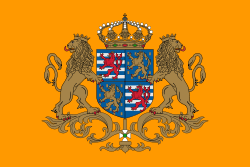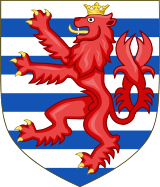Grand Duke of Luxembourg
| Grand Duke of Luxembourg | |
|---|---|
|
Coat of Arms of Luxembourg | |
| Incumbent | |
.jpg) | |
| Henri | |
| Details | |
| Style | Royal Highness Majesty |
| Heir apparent | Guillaume, Hereditary Grand Duke of Luxembourg |
| First monarch |
William I of the Netherlands (1815) (personal union began) Adolphe, Grand Duke of Luxembourg, (after 1890) (As a Sovereign Grand Duke) |
| Formation | March 15, 1815 |
| Residence | Grand Ducal Palace in Luxembourg |
| Website | www.monarchie.lu (french only) |
The Grand Duke of Luxembourg is the monarchial head of state of Luxembourg. Luxembourg has been a grand duchy since 15 March 1815, when it was elevated from a duchy, and was in personal union with the Netherlands until 1890. Since 1815, there have been 9 monarchs of Luxembourg, including the incumbent, Henri. Since 1890, all grand dukes/duchesses of Luxembourg have ruled as sovereign monarchs.

Constitutional role
The Constitution of Luxembourg defines the grand duke's position:
| “ | The Grand Duke is the head of state, symbol of its unity, and guarantor of national independence. He exercises executive power in accordance with the Constitution and the laws of the country.[1] | ” |
After a constitutional change (to article 34) in December 2008 resulting from Henri's refusal to sign a law legalizing euthanasia, laws now take effect without the grand duke's assent.[2] As a result, the grand duke no longer has any formal role in the legislative process, but his task to promulgate the law as chief executive remains.
Succession
Succession to the throne was governed by Salic law, as dictated by the Nassau Family Pact, first adopted on 30 June 1783.[1] The right to reign over Luxembourg was until June 2011 passed by agnatic-cognatic primogeniture within the House of Nassau, as stipulated under the 1815 Final Act of the Congress of Vienna and as confirmed by the 1867 Treaty of London.[1] The Nassau Family Pact itself can be amended by the usual legislative process, having been so on 10 July 1907 to exclude the Count of Merenberg branch of the House, which was descended from a morganatic marriage.[3]
An heir apparent may be granted the style 'Hereditary Grand Duke'. The current heir apparent is Hereditary Grand Duke Guillaume. In June 2011, agnatic primogeniture was dropped in favor of absolute primogeniture, allowing any legitimate female descendants within the House of Nassau to be included in the line of succession.[4]
Full titles
.svg.png) |
| This article is part of a series on the politics and government of Luxembourg |
| Constitution |
|
Monarchy |
|
| Foreign relations |
|
Politics portal |
The current grand duke, Henri, bears the full style: By the Grace of God, Grand Duke of Luxembourg, Duke of Nassau, Count Palatine of the Rhine, Count of Sayn, Königstein, Katzenelnbogen and Diez, Burgrave of Hammerstein, Lord of Mahlberg, Wiesbaden, Idstein, Merenberg, Limburg and Eppstein. It should, however, be noted that many of the titles are held without regard to the strict rules of Salic inheritance.

List of grand dukes
Since 1815, there have been seven grand dukes of Luxembourg and two grand duchesses regnant of Luxembourg. Only three Dutch monarchs have used and controlled both the land and the title as the Grand Duke of Luxembourg until 1890.
- William I (1815–1840) First Dutch king to rule as Grand Duke of Luxembourg.
- William II (1840–1849)
- William III (1849–1890) Last Dutch king to rule as Grand Duke of Luxembourg.
Grand Dukes of Luxembourg after William III of the Netherlands ruled separately as an independent country after the personal union with the Netherlands ended in 1890, making Adolphe, Grand Duke of Luxembourg, the first independent Grand Duke of Luxembourg.
- Adolphe (1890–1905)
- William IV (1905–1912)
- Marie-Adélaïde (1912–1919) First Grand duchess of Luxembourg and first Luxembourgish monarch to be born on Luxembourgish territory since John the Blind the king of Bohemia born in 1296.
- Charlotte (1919–1964)
- Jean (1964–2000)
- Henri (2000–present)
Grand Ducal Consorts
- Princess Wilhelmine of Prussia (first wife of Grand Duke William I)
- Countess Henriëtte d'Oultremont de Wégimont (second and morganatic wife of Grand Duke William I)
- Grand Duchess Anna Pavlovna of Russia (wife of Grand Duke William II)
- Princess Sophie of Württemberg (first wife of Grand Duke William III)
- Princess Emma of Waldeck and Pyrmont (second wife of Grand Duke William III)
- Princess Adelheid-Marie of Anhalt-Dessau (wife of Grand Duke Adolphe)
- Infanta Marie Anne of Portugal (wife of Grand Duke William IV)
- Prince Felix of Bourbon-Parma (husband of Grand Duchess Charlotte)
- Princess Joséphine Charlotte of Belgium (wife of Grand Duke Jean)
- María Teresa Mestre y Batista-Falla (wife of Grand Duke Henri)
See also
Footnotes
- ↑ 1.0 1.1 1.2 "Constitution de Luxembourg" (PDF) (in French). Service central de législation. Retrieved 2007-07-01.
- ↑ "Luxembourg strips monarch of legislative role". The Guardian (London). 12 December 2008. Retrieved 4 May 2010.
- ↑ (French)/(German) "Mémorial A, 1907, No. 37" (PDF). Service central de législation. Retrieved 2008-01-14.
- ↑ "New Ducal succession rights for Grand Duchy". Luxemburger Wort. 21 June 2011. Retrieved 11 July 2011.
References
- "Constitution de Luxembourg" (PDF) (in French). Service central de législation. Retrieved 2008-01-14.
External links
- www.monarchie.lu (French only)
| ||||||||||||||||||||||||||||||||||||||||||||||
| |||||||||||||||||||||||||||||||||||||||||||||||||||||||||||||||||||||||||||||||||||||
| ||||||


